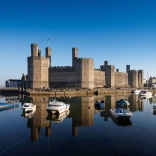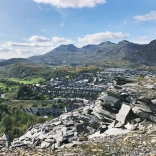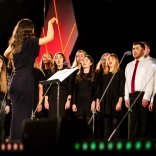On the surface, it might seem like there are few cultural connections spanning the 5,500 miles (8,850km) or so that separates Wales and Japan. But there are actually a number of links, across arts, history, business and even cuisine, that web together our two great nations, with more ties being forged all the time.
Sibling strongholds
The only UNESCO World Heritage Sites to be “twinned” together are Conwy Castle in North Wales and Himeji Castle in Hyogo, Japan. The former, sitting on the banks of the River Conwy is known for for its imposing stone curtain wall and lofty towers, while Himeji Castle, nicknamed Shirasagijo (White Heron Castle), after its bright white walls and its position perched at the top of a hill, is largely constructed from wood and consists of 83 separate buildings.
Though visually distinctive, the two fortresses are both considered to be amongst the best surviving examples of castle architecture from their respective cultures, and were actually built within 50 years of one another. The twinning status, completed in 2019, aims to promote sustainable tourism in both Conwy and Hyogo and encourage the exchange of knowledge and skills around preservation.


Inspiring Studio Ghibli
From historic castles to floating ones: legendary Japanese animator, and founder of Studio Ghibli, Hayao Miyazaki, turned to the South Wales Valleys for inspiration during the production of the studio’s debut release, Laputa: Castle in the Sky. Miyazaki travelled to Wales twice, and based a number of the film’s landscapes on the Welsh mining towns he visited.
On his trip, Miyazaki also witnessed the Welsh Miners’ Strikes of the 1980s, which had a lasting impact on the storyteller. Miyazaki felt sympathy towards the men struggling to protect their livelihoods – a theme echoed in Castle in the Sky.
That’s not the studio’s only Welsh link, however. The fantasy novel Ghibli’s 2004 classic, Howl’s Moving Castle, is based upon, is partly set in Wales, and its protagonist, Howl, is actually Welsh: his real name is Howell Jenkins. It is thought that some smaller elements in Studio Ghibli’s other works were inspired by Welsh myths and legends.
Exchanging art
Many Welsh artists have been inspired by Japanese culture and worked or exhibited in Japan – and vice versa. A partnership between The National Museum of Wales and the Modern Art Museum of Japan has led to a number of Japanese-themed exhibitions on Welsh soil, including a popular showcase in National Museum Cardiff aptly-titled Kizuna (bonds). The exhibition displayed Japanese cultural artefacts from the 1600s to the present day, many of which had never been seen before in the UK.
Wales has also hosted other exhibitions of works by Japanese artists, including Sakubei Yamamoto, whose watercolours, which depict his memories of working in the Japanese coal mining industry, went on show in the UNESCO World Heritage Site Big Pit Museum in 2019. In addition, the Kotatsu Japanese Animation Festival brings some of the best animated works from Japan to the big screens in Welsh arts venues each autumn, and has been running since 2010.
Japan has also hosted works of many Welsh creatives in group exhibitions over the years. These have included the works of David Nash at The Museum of Contemporary Art in Tokyo, a collection of Dylan Thomas works in Kyoto and a design exhibition featuring twelve glass and ceramic artists from Wales in Oita.

A soft spot for seaweed
It’s not just the art world where we have shared tastes. Seaweed is recognised as a staple of the Japanese diet, but it’s also beloved here in Wales – so much so that it has its own day of celebration. One of our most famous actors, Richard Burton, even bestowed seaweed – or ‘laverbread’ as it is known in Wales – the title of ‘Welshman’s Caviar’.
The connection doesn’t end there: British biologist Kathleen Drew-Baker is revered in Japan (where she is known as the Mother of the Sea), thanks to her work on commercial seaweed cultivation, her studies into which were undertaken on the beaches of Wales.
Bonding through business
Wales and Japan have also established strong ties through economic ventures. These date back to the 19th century, when Japan developed its railway network with steel and iron from Dowlais Works in Merthyr Tydfil.
In the years since, many Japanese companies have established a presence in Wales, including Sony, Panasonic and Marubeni, with Japanese-owned companies thought to employ around 6,000 people in Wales today. There is even a members club for Japanese executives who have spent time working in Wales, Clwb Hiraeth, which was established in 1982.
A love for rugby
Another shared passion between Japan and Wales is rugby. In fact, it was during a match between the two nations in 1975 that Koji Tokumasu, a key figure responsible for bringing the Rugby World Cup to Japan in 2019, fell in love with the game (two years later, Koji would travel to Wales to study Rugby Coaching at Cardiff Metropolitan University). During the World Cup in Japan, Wales received a huge amount of support from the Japanese public, with 15,000 Japanese fans packing into Kitakyushu stadium just to watch the Wales team train – and they even sung a rousing rendition of the Welsh national anthem.
Further rugby-based ties come in the form of Shane Williams MBE, one of Wales’ greatest ever players. Having spent most of his life playing rugby for the Ospreys, based in Swansea, Shane opted to finish his career in Japan, playing for club side Mitsubishi Sagamihara Dynaboars.




